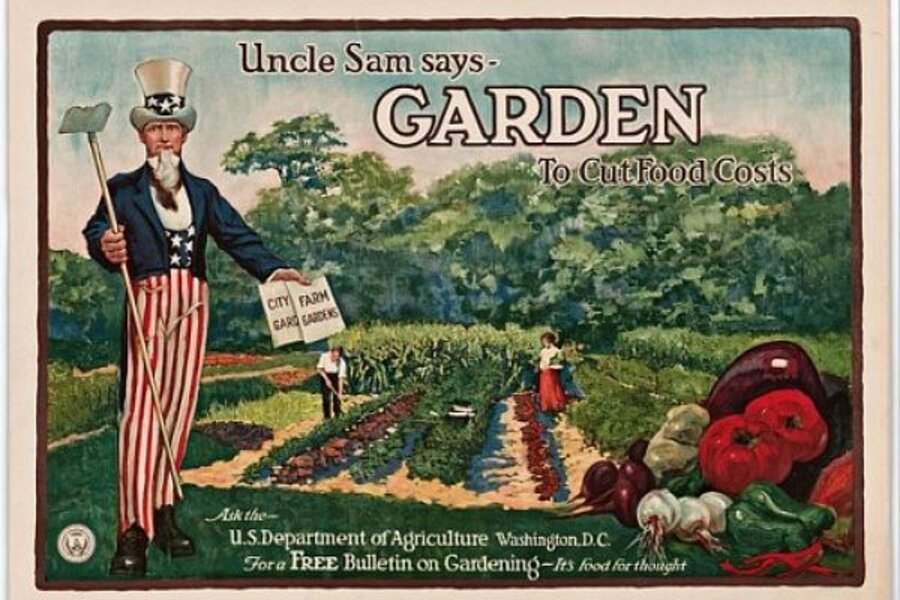'What's Cooking, Uncle Sam?'
Loading...
"What’s Cooking Uncle Sam" is the newest exhibition on view at the National Archives in Washington, D.C. It is a show that traces the government’s role in both food production and consumption of the Unites States. The exhibition features a collection of office stationery ranging from posters and pamphlets to product labels and photographs of the various meals enjoyed by presidents. I asked the curator, Alice Kamps, a few questions regarding the National Archives collection and the exhibition which will be on view until January 3, 2012.
Interview with Alice Kamps, exhibition curator
What do you collect today of the American food culture for the exhibitions and collections of tomorrow?
The National Archives keeps the documents and materials created in the course of business conducted by the United States Federal government that are judged to be important for legal or historical reasons. These materials are preserved because they are important to the workings of Government, have long-term research worth, or provide information of value to citizens. The records created in the course of Government initiatives, legislation, and programs that relate to food are among these records.
There are a number of advertisements for food and products in the exhibition, do you collect and document the digital advertising on the internet and through email?
The food advertisements and labels in the exhibition were submitted to the Government in the course of various government activities. The National Archives keeps digital and other advertising records from government files that are judged to be of historical value.
What about food blogs? Are you archiving any websites in their entirety in order to preserve them for future generations?
The National Archives archives blogs and other electronic records created in the course of government business.
How did you approach curating this exhibition? Are there any predominate themes running throughout the collection?
After surveying food records from a variety of different government agencies, I decided to narrow the scope by focusing on those that tell interesting stories about how Government affects our food supply and food choices. These included things like agricultural activities, nutrition education programs, food safety regulation, school lunch, and military food service. Many of the themes in the exhibit echo today’s concerns about food: the safety of additives, the diversity of plants, and the nutritional quality of the foods we eat.
Looking at the food and nutrition of yesterday, have you learned any important information that is relevant today?
It was fascinating to learn about the evolution of our understanding of nutrition and the ways it has shaped the foods we eat. As science revealed new insights about the nutritional value of different foods, our approach to food became more scientific. There was a movement away from eating foods simply for pleasure or cultural tradition to eating foods that are “good for us.” With the benefit of hindsight, we can see where particular ideas about nutrition were overblown or simply inaccurate. We might consider this before we make drastic changes in our diet based on the latest scientific discoveries.
What is your favorite work in the exhibition?
I have many “favorites” but ... one of them [is] photograph of a nutrition demonstration done in the course of a 4-H program. I love the fact that the women are wearing what look like nurse’s uniforms and are presenting what appears to be a cake made from whipped cream and some kind of cookies. It isn’t exactly what we would call nutritious today, not that we wouldn’t still enjoy eating it. But it meets their standards: it’s economical, quickly made, nutritious, attractive, and delicious. These were attributes that were highly valued by home economists. They believed that it was wasteful and inefficient to spend a lot of time and money on cooking.
‘What’s Cooking, Uncle Sam? The Government’s Effect on The American Diet’ is on view starting 10 June 2011 until 3 January 2012 in The Lawrence F. O’Brien Gallery of the National Archives in Washington D.C.
Megan Fizell deconstructs fine art into recipes at Feasting On Art.
To see a photograph of President Nixon's last White House breakfast, click here.
--------------------------------------------------------------
The Christian Science Monitor has assembled a diverse group of food bloggers. Our guest bloggers are not employed or directed by The Monitor and the views expressed are the bloggers' own and they are responsible for the content of their blogs and their recipes. All readers are free to make ingredient substitutions to satisfy their dietary preferences, including not using wine (or substituting cooking wine) when a recipe calls for it. To contact us about a blogger, click here.






